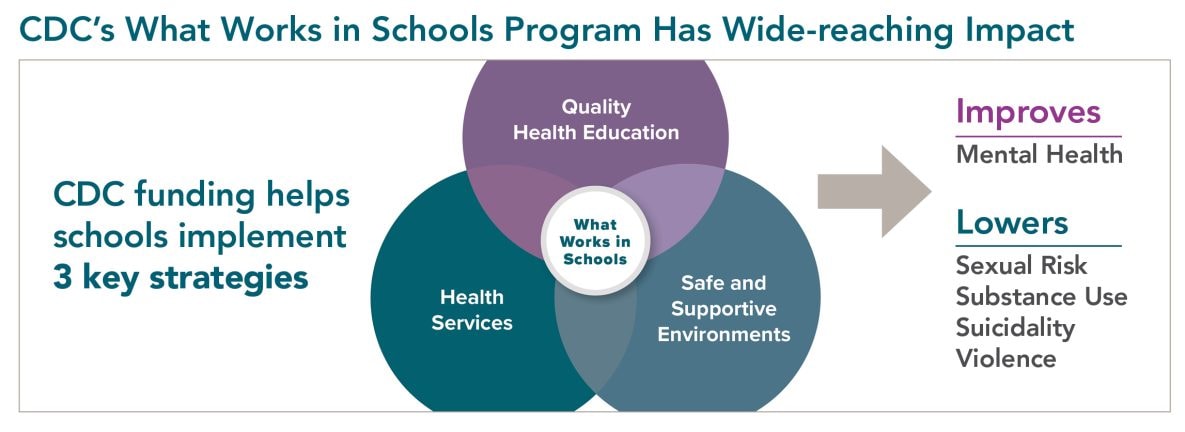What Works In Schools Program
CDC’s school-based program that prevents adolescent health risks.
Key Takeaways
- CDC’s What Works In Schools program helps promote adolescent health and wellbeing.
- The program supports the implementation of quality health education, increases connections to needed health services, and improves the safety and supportiveness of school environments for middle and high school students.
- Schools that implement What Works In Schools see improvements in health behaviors and mental health among their students.
What is What Works In Schools?
What Works In Schools is an approach to school-based health that has been shown to improve health behaviors and experiences, support mental health and reduce suicidality in schools that implement the program. The program works by:
- Improving health education,
- Connecting young people to the health services they need, and
- Making school environments safer and more supportive.

Participating schools saw decreases in sexual risk behaviors among students and decreases in students who use marijuana, who miss school because of safety concerns, and who experience forced sex.

What Works In Schools can help to reverse negative trends and ensure that youth have the support they need to be healthy and thrive.
Quality health education
Quality health education ensures that young people have the knowledge and skills they need as they navigate adolescence and can set the stage for positive health and well-being into adulthoods. Quality health education should be:
- Age appropriate,
- Culturally relevant,
- Medically accurate,
- Taught by qualified and trained teachers, and,
- Based on a strong health curriculum.
Health education that meets these requirements gives students the knowledge and skills they need to make good health choices.
Access to health services
Schools can help increase student access to health services, including mental and behavioral health services, by providing on-site school services or by referring students to youth-friendly sources of care in the community. Schools can support student access to services by assessing the needs of students as well as the availability of on-site services and establishing relationships and referral systems to community sources of care.
Safe and supportive school environments
School environments that are safe and support young people help them feel connected to their peers and adults in their schools. This sense of connectedness has been show to have long lasting impact on health and well-being.
Schools can improve connectedness by:
- Making sure teachers have the training they need to manage the mental and behavioral health issues of students in their classrooms.
- Providing opportunities for positive youth development, including school and community service programs and mentoring.
- Ensuring that schools are safe for the most vulnerable youth through anti-harassment policies, providing safe spaces, inclusive clubs, and professional development for school staff.
LGBTQ+ inclusive policies and practices benefit all students – not just LGBTQ+ students.
When schools implement LGBTQ-supportive policies and practices, all students experience:
- Less emotional distress
- Less violence and harassment
- Less suicidal thoughts and behaviors
Safe and Supportive Environments Positively Impact Adolescent Behaviors and Experiences
